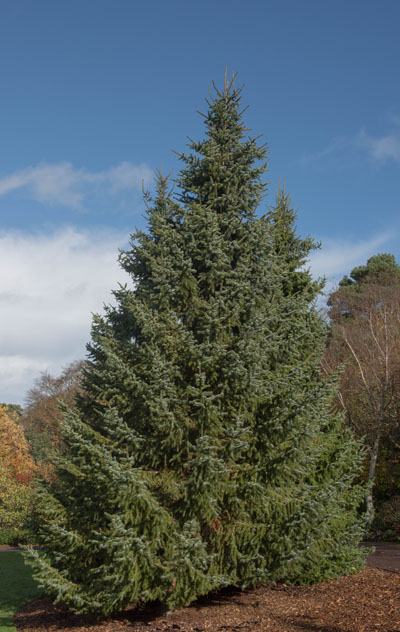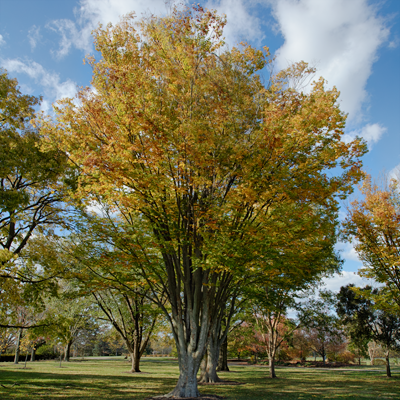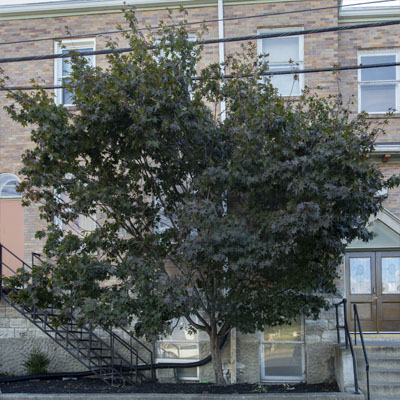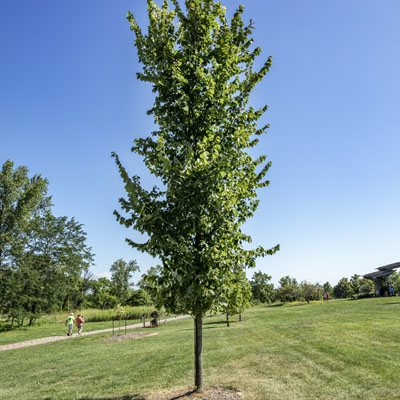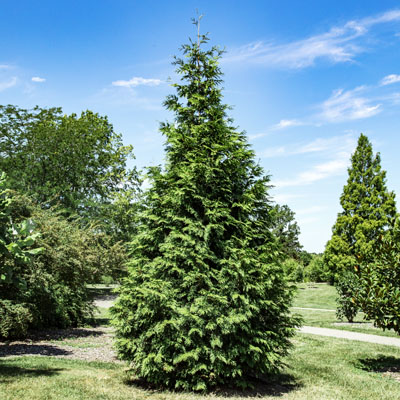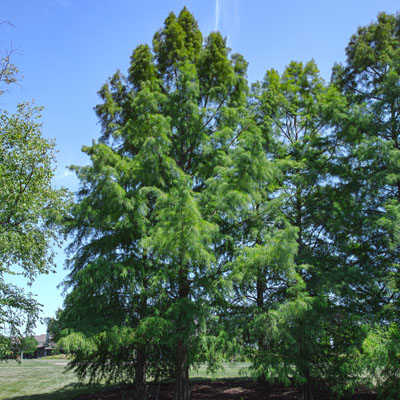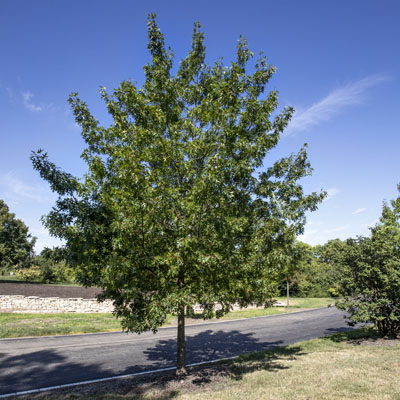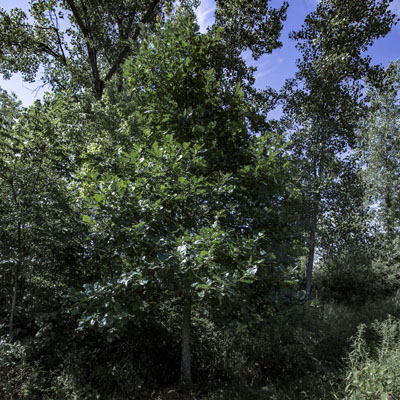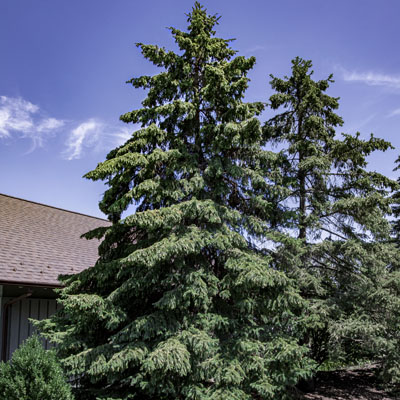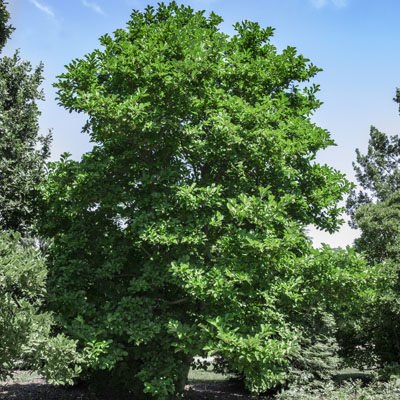Tree Dictionary
Serbian Spruce
Picea omorika
Serbian spruce is an evergreen conifer that is grown for its tall, slender form and dark green foliage with white stripes on the undersides of needles. Its trunk remains slender as it matures, and its bark is scaly and brown. The cones that grow at the ends of its branches are another attractive feature, emerging purple and changing to brown at maturity.
Serbian spruce’s upward pointing branch tips combined with its hanging foliage make it a striking landscape specimen, while its tough nature makes it adaptable to a range of site conditions. With its upright form and mature height, Serbian spruce will stand out in any setting.
Jane Magnolia
Magnolia x 'Jane'
'Jane' is a small-scale, graceful magnolia that’s ideal for gardens. ‘Jane’ is a magnolia cross that is part of a group of magnolia cultivars developed at the National Arboretum. It’s a late-blooming magnolia, so there is less chance that early blooms will suffer frost damage. When its flowers open, they are large, red-purple with white interiors, and are fragrant.
‘Jane’ can be pruned to form a multi-trunk tree so its branches can best display its large, profuse spring flowers. You can use ‘Jane’ as a specimen or accent tree, or add it to woodland landscapes and mixed borders. Position it so its spring bloom and fall color can be easily viewed.
Because of its naturally shrubby form, ‘Jane’ can be massed to make a loose, informal screen.
'Crimson Spire' English Oak
Quercus robur x alba 'Crimschmidt'
‘Crimson Spire’ oak is a beautiful hybrid between English oak and White oak, and was selected for its narrow form and showy, reliable red fall color. As its cultivar name suggests, its narrow, upright branching is maintained into maturity. It is tolerant of a wide range of conditions but prefers well-drained soil.
Like its oak parents, ‘Crimson Spire’ has furrowed bark and dark green, lobed leaves, and its acorns are an important winter food source for wildlife. It is native to woodlands, but its tolerance of a range of environmental conditions mean that it is regularly grown in urban settings.
‘Crimson Spire’ grows in USDA Zones 4-7.
Green Vase Zelkova
Zelkova serrata 'Green Vase'
Zelkova serrata is a beautiful deciduous tree that can be planted in parks, used as a shade tree or a street tree, and as a tree for your garden. While its graceful shape and small leaves might suggest delicacy, its hardiness makes it a good choice for parking lots and as a buffer or screening tree.
This tree produces small seeds that do not cause litter problems and, like all zelkovas, has attractive, pointed, elm-like green leaves.
‘Green Vase’ zelkova is noted for its vase shape, fine foliage, and attractive gray bark that flakes and exposes cinnamon-colored inner bark. Because of its resemblance to elm (Ulmus) species and its resistance to Dutch elm disease, it is often used as a substitute for elm trees.
‘Green Vase’ grows in USDA Zones 5-8.
Bloodgood Japanese Maple
Acer palmatum 'Bloodgood'
‘Bloodgood’ Japanese maple is an excellent garden or accent tree. Its small size and sweeping branches are beautiful both when covered in leaves and when bare in winter. ‘Bloodgood’ can be grown as a single-trunked standard or a multi-trunk specimen. Multi-trunked trees are valued for their branching patterns and their display of leaves.
‘Bloodgood’ is a good addition to woodland gardens or as an understory shrub or tree.
It is native to Asia, but will grow wherever its cultural requirements are met, including here in the Dayton area. It requires a regular level of moisture and some shade when planted in hot areas, and prefers acidic soil.
‘Bloodgood’ grows in USDA Zones 5-8.
Princeton American Elm
Ulmus americana 'Princeton'
The Princeton American Elm is more resistant to Dutch Elm Disease than other elm trees (which is why, in 2005, about 90 Princeton elms were planted on Pennsylvania Avenue leading to the White House).
The 'Princeton' cultivar of the American elm grows 50 to 70 feet tall and 30 to 50 feet wide, so be sure it has plenty of room to grow if you plan on planting one. It's extremely fast-growing, and prefers full sun and rich, well-drained soil.
Because it grows so rapidly, proper maintenance pruning is important. It may be susceptible to Japanese beetles, so look for signs of the leaves being eaten.
Western Red Cedar / Arborvitae
Thuja plicata 'Green Giant'
This native arborvitae hybrid is fast-growing, neat in appearance, and often substituted for Leyland cypress. Left alone, the tree can reach a height of 60’ but is easily kept smaller. Unlike other tree species, ‘Green Giant’ responds well to pruning. It has a naturally narrow spread, to 18’, which makes it useful for smaller gardens and as a screening hedge.
Common Bald Cypress
Taxodium distichum
Though you might think of the bald cypress as a tree that grows in swampy conditions, it does just as well on dry ground here in Ohio. (You might often find them planted around lakes, too).
This type of tree is one of the few deciduous conifers; it loses its needles every fall (hence the name, "bald,") and grows them back every spring. The reddish-brown fall color of the leaves is why we have it listed as one of our best trees for fall color.
Bald cypress can live a very long time (one that was recently discovered is considered to be over 2,000 years old) and grow very large. Ensure that you have enough room for a tree 50 to 80 feet tall and 23 to 30 feet wide (and keep in mind that the roots usually grow out 2-3x further than that!) It likes full or partial sun, slightly acidic and wet soil. The lacy needles will fall off each fall, so don't plant the tree near a driveway unless you want needles all over your car. Overall, it's a great tree that grows well here, is different from your usual conifer, and provides some interest in the fall.
Scarlet Oak
Quercus coccinea
The Scarlet Oak is a resilient tree that can handle drought and poor soils, making it a good choice as a street tree (as well as a wonderful specimen tree in your yard). But what really sets it apart is the stunning dark red foliage in fall. While the leaves on most oak trees simply turn brown or yellowish in autumn, the leaves of Scarlet Oak are one of the most colorful contributors to the fall foliage display, turning bright red before falling.
Growing to 75' high and 50' wide, this oak is best planted in large, open areas where it has a chance to show off its large size and spread.
It has no serious pest or disease problems but does prefer acidic soil (you may need to amend your soil to achieve this).
Swamp White Oak
Quercus bicolor
With a name like Swamp White Oak, you may think that this tree only survives in wet, swampy conditions, but that's not the case. While it does grow well in moist, poorly-drained soil, it is native to the Midwest, so it's happy in normal or dry soils as well.
Part of its scientific name, bicolor, refers to the leaves, which are shiny green on one side but a silvery-white on the other. While the wood of the swamp white oak is very similar to that of the white oak, it can be distinguished by its leaves.
A large tree, a swamp white oak grows rather quickly and can reach 70 feet tall and 60 feet wide, so make sure there is plenty of room for it to grow.
If you do plant a swamp white oak, be prepared for a bit more wildlife, as the acorns are a wonderful food source for squirrels and other animals. It likes full sun, has interesting color in the fall, and a flaky bark to bring year-round interest to your yard.
Black Hills Spruce
Picea glauca 'Densata'
The state tree of South Dakota, the Black Hills Spruce is a tough tree that is an excellent choice as an accent tree or used as a windbreak. It's a dense, slow-growing tree that reaches 40' tall at maturity with a narrow 15' spread and has fine bluish-green needles. It has no severe pest issues but appreciates moist, well-drained soil and does best when given room to grow with ample air circulation.
Dr. Merrill Magnolia
Magnolia loebneri 'Merrill'
With its large, fragrant, star-like white flowers in spring and its pointy leaves that turn copper in the fall, 'Dr. Merrill' makes a real statement in the landscape. Growing to 25 feet tall and 30 feet wide, this pyramidal-shaped tree does best in full to partial shade. It does not do well in urban environments (due to pollution), and it prefers well-drained and acidic soil. After planting, it might take a few years for the blooms to appear.

